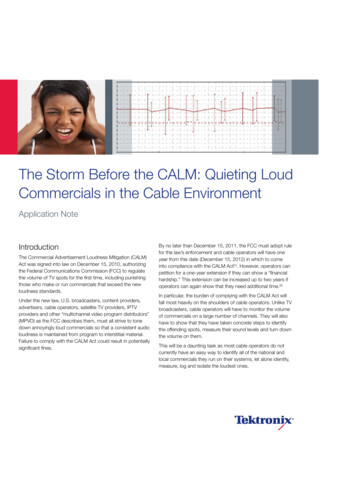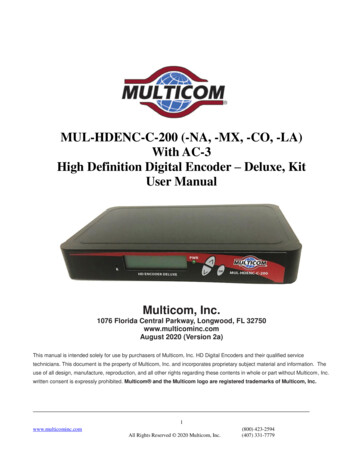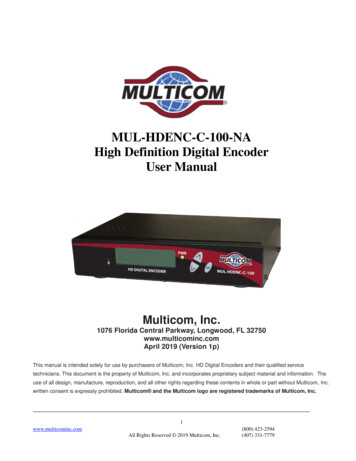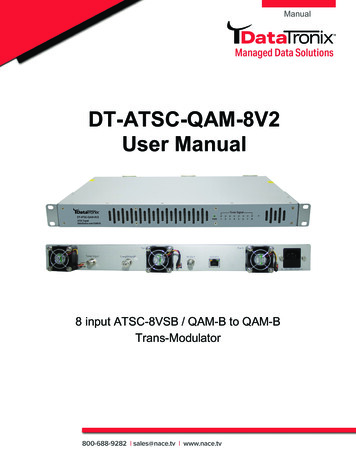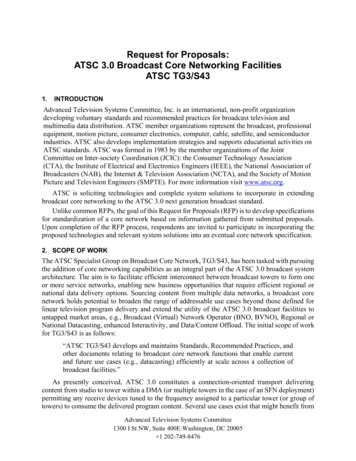
Transcription
Request for Proposals:ATSC 3.0 Broadcast Core Networking FacilitiesATSC TG3/S431.INTRODUCTIONAdvanced Television Systems Committee, Inc. is an international, non-profit organizationdeveloping voluntary standards and recommended practices for broadcast television andmultimedia data distribution. ATSC member organizations represent the broadcast, professionalequipment, motion picture, consumer electronics, computer, cable, satellite, and semiconductorindustries. ATSC also develops implementation strategies and supports educational activities onATSC standards. ATSC was formed in 1983 by the member organizations of the JointCommittee on Inter-society Coordination (JCIC): the Consumer Technology Association(CTA), the Institute of Electrical and Electronics Engineers (IEEE), the National Association ofBroadcasters (NAB), the Internet & Television Association (NCTA), and the Society of MotionPicture and Television Engineers (SMPTE). For more information visit www.atsc.org.ATSC is soliciting technologies and complete system solutions to incorporate in extendingbroadcast core networking to the ATSC 3.0 next generation broadcast standard.Unlike common RFPs, the goal of this Request for Proposals (RFP) is to develop specificationsfor standardization of a core network based on information gathered from submitted proposals.Upon completion of the RFP process, respondents are invited to participate in incorporating theproposed technologies and relevant system solutions into an eventual core network specification.2. SCOPE OF WORKThe ATSC Specialist Group on Broadcast Core Network, TG3/S43, has been tasked with pursuingthe addition of core networking capabilities as an integral part of the ATSC 3.0 broadcast systemarchitecture. The aim is to facilitate efficient interconnect between broadcast towers to form oneor more service networks, enabling new business opportunities that require efficient regional ornational data delivery options. Sourcing content from multiple data networks, a broadcast corenetwork holds potential to broaden the range of addressable use cases beyond those defined forlinear television program delivery and extend the utility of the ATSC 3.0 broadcast facilities tountapped market areas, e.g., Broadcast (Virtual) Network Operator (BNO, BVNO), Regional orNational Datacasting, enhanced Interactivity, and Data/Content Offload. The initial scope of workfor TG3/S43 is as follows:“ATSC TG3/S43 develops and maintains Standards, Recommended Practices, andother documents relating to broadcast core network functions that enable currentand future use cases (e.g., datacasting) efficiently at scale across a collection ofbroadcast facilities.”As presently conceived, ATSC 3.0 constitutes a connection-oriented transport deliveringcontent from studio to tower within a DMA (or multiple towers in the case of an SFN deployment)permitting any receive devices tuned to the frequency assigned to a particular tower (or group oftowers) to consume the delivered program content. Several use cases exist that might benefit fromAdvanced Television Systems Committee1300 I St NW, Suite 400E Washington, DC 20005 1 202-749-8476
S43-019r9RFP for ATSC 3.0 Broadcast Core Networking Capabilities15 October 2021a more dynamic, service-based architecture with clear control/data plane separation deliveringcontent sourced outside of conventional studio encoding, spanning multiple DMAs, and potentiallytaking part in a heterogenous network arrangement formed in cooperation with one or morebroadband access technologies, e.g., Wi-Fi, 3GPP 4G/5G, satellite, etc. as shown in Figure 1.Figure 1 Core Network features.Built on a native IP transport, ATSC 3.0 is particularly well-suited to carry internet traffic andother data content alongside traditional television programming. A broadcast operator can allocateone or more Physical Layer Pipes (PLPs), configured to ensure reliable fixed or mobile receptionas prescribed by the content provider, expanding market access to include Internet of Things (IoT)datacasting, broadcast/multicast traffic offload, vehicular data download and software updatealongside linear television program delivery. With the addition of core networking facilities,ATSC 3.0 broadcasts can be provisioned to render spare capacity on an as-needed basis to providea complementary Broadcast Internet transport. This added capacity might be delivered from morethan a single tower, across multiple frequencies spanning transmission coverage areas. Scalabilityinherent to a core network architecture has been deemed essential in enabling widespreaddistribution with minimal added overhead as compared to operating each tower (or group oftowers) independently.The ATSC Specialist Group on Broadcast Core Network, TG3/S43, will consider informationpertaining to relevant core networking capabilities. Wherever practical, the group will considerutilizing and referencing existing standards that are found to be effective in meeting the full rangeof system requirements. With the addition of a broadcast core network, service provisioning fordata/content delivery across multiple transmission coverage areas should be at least as efficient asthat of provisioning for content delivery in a single coverage area as presently defined in ATSC3.0. The respondent is invited to recommend a method for assessing the efficiency of serviceprovisioning, indicating how their proposal might fare in accommodating use cases ranging fromsingle to multiple transmission coverage areas and how performance can be measured andcompared for different deployment scenarios.2
S43-019r9RFP for ATSC 3.0 Broadcast Core Networking Capabilities15 October 2021Consideration will be given to technologies and proposals that enable a smooth transition fromexisting systems for both broadcasters and consumers.Investigation of any new technology would involve assisting the group in forming a detailedunderstanding of the proposed network functions and features and evaluations of its ability to meetthe performance requirements. If agreement is reached that the requirements have been met andthe system would benefit from the proposed technology, the proposed capability may beincorporated into the suite of ATSC 3.0 standards, potentially as a new standard and/or anAmendment to an existing standard, via the standardization process described in ATSC’sdocumented policies.3.ACRONYMSThis section defines specific acronyms commonly used in discussions concerning core networking,which will be adapted as needed to extend its use in describing core networking facilities for theATSC 3.0 broadcast system. The acronyms defined in Table 1 are common terms, and may, insome cases, map to alternative terms used by individual systems in other parts of ATSC 3.0.Table 1 Core Networking ESBASFNSIMSMSUDRThird Generation Partnership ProjectFourth-Generation mobile technologyFifth-Generation mobile technologyAccess and Mobility FunctionAdvanced Television Systems CommitteeAccess Traffic Steering, Switching and SplittingAUthentication Server FunctionBroadcast Virtual Network OperatorCommon Alerting ProtocolContent Delivery NetworkDirect Terrestrial TelevisionFile Delivery over Unidirectional TransportInternet of ThingsInternet ProtocolMultiple Frequency NetworkNetwork FunctionNon-Real TimeOver the AirPhysical LayerPhysical Layer PipeRadio Access NetworkRadio Access TechnologyReal-time Object delivery over Unidirectional TransportSecure/Multipurpose Internet Mail ExtensionsService Based ArchitectureSingle Frequency NetworkSubscriber Identity ModuleSubscriber Management SystemUnified Data Resource3
S43-019r9UEUDMWi-FiWLANXMLRFP for ATSC 3.0 Broadcast Core Networking Capabilities15 October 2021User EquipmentUser Data ManagementWireless Fidelity (802.11x)Wireless Local Area NetworkeXtensible Markup Language4. EVALUATIONRespondents to this RFP are encouraged to provide thoughts on how any newly developed ordeveloping core networking facilities might best be evaluated in comparison to other availablecore networking capabilities. There is interest in understanding whether it may be more effectiveto use subjective evaluation techniques or to apply mechanical, automatic, or computer-basedevaluation tools and/or processes that are appropriate for the technology of interest. Definitionsfor terms used in the following subsections can be found in Appendix C.4.1 Functional RequirementsResponses to this RFP must contain information about each of the below main functionalrequirements that a broadcast core network shall provide:1) Identify each use case supported by the proposal and the network functions (NF) that arerequired to satisfy the use case.2) Satisfy the datacasting use case.3) For each use case, describe the functionality of the identified NFs.4) Describe at a high level the mechanics of how legacy broadcast networks interface withthe new NFs (e.g., identify the protocol stack, identify the application layer protocoloperations and relevant error codes).5) Describe the means by which the use cases and supporting NFs identified in #1 authenticateand authorize clients (i.e., broadcast networks) that request services from the core network.6) Be capable of operating with or without consumer interactivity (client having a returnchannel to broadcast core), understanding that some use cases require a return channel thatis always available or sometimes available while other use cases do not require a returnchannel.7) For use cases that require a return or interactive channel, be capable of integration withmultiple return path radio access technologies.8) Enable coordinated service across multiple transmission facilities.9) Identify any non-backward compatible elements with existing systems and receivingdevices.10) Define the general implementation of core network (i.e., Network function virtualizationinfrastructure):a) Type of infrastructure that hosts the network functions.b) On what network technologies are based.c) Security boundaries and characteristics:i) How external entities can interact securely with the broadcast core network toaccess its services and functions.4
S43-019r9RFP for ATSC 3.0 Broadcast Core Networking Capabilities15 October 2021ii)How core network can securely communicate with broadcast elements within eachtransmission facility.d) How to scale the core network with number of services and number of end users.11) For each use case included in the proposal, define the following:a) The purpose of the use case.b) The user story, i.e., a simple description told from the end user perspective.c) To what extent it depends on a return path from the client (always, sometimes, or notrequired).d) If it will be impacted with geo-location.e) The NFs required to satisfy the use case.f) The traffic flow or flow chart for the use case.12) For each NF define the followinga) The name of NF.b) The purpose of NF.c) The interfaces of the NF that need to be exposed.d) How to access the NF by other NFs.e) How to secure the NF.f) How the NF can be scaled up/down with the number of services or number of users.4.2 Design ConsiderationsResponses to this RFP are encouraged to address the below broadcast core network functions thatmay not be required, but may be highly beneficial:1) Provide improvements in performance, functionality, and efficiency that are significantenough to warrant the challenges of a transition to a new system.2) Design to be modular, flexible, and future proof, to the extent possible.3) The core network architecture should be based upon SBA principles (Rest API, serviceoriented architecture).4) Minimize changes to the existing systems and devices. The addition of core networkingcapability should not preclude, harm, or in any way undermine critical existing services.5) Enable user Geo-location/Roaming – restriction for the return channel enabled use cases;i.e., when a client is crossing the borders from one transmission area to another, roamingrules may apply. The core network will include policies that guide service deliveriesaccording to business rules.6) Define necessary NFs that allow interworking among broadcast cores.7) Define necessary NFs that allow a station owner to share capacity resources to another corenetwork.8) Enable auto-discovery of services by receivers (UEs) either through an OTA controlchannel, or via a return channel when the ATSC receiver device is connected to the corenetwork.9) Describe the use case of inter-tower communication among transmission facilities from acore network perspective; please highlight any security measures to be considered.5
S43-019r9RFP for ATSC 3.0 Broadcast Core Networking Capabilities15 October 202110) Define the minimum requirement to establish a return path to the core network from theATSC receiver device (i.e., bandwidth, latency) per use case.11) Define how the core network will interface with each proposed return path technology.12) Describe how the core network will interoperate with point-to-point communicationfacilities connection (i.e., for backhaul links).13) Operation and maintenance:a) Describe how the core network allows service provisioning into one of multipletransmission facilities by means of orchestration NFs.b) Describe how NFs with the core network allow service monitoring and servicefailover should an issue arise.c) Describe how core network functions will provide the status of:i) Provisioned services.ii) Transmission facilities (online, offline, maintenance mode, etc.).iii) Spectrum used within each transmission facility.iv) Services allocated for each transmission facility.v) History of errors encountered within each transmission facility.5. SCHEDULE5.1 RFP Response DeliverablesDeliverables in response to this RFP are listed as follows: Respondent Information Form (Appendix A). Overview of the proposed solution. Statement regarding Bylaws and Procedures Review and agreement. Statement indicating intent to comply with the ATSC Patent Policy. Statement indicating intent to comply with the ATSC Copyright and Reference Policy. Statement Regarding Respondent Resources. Detailed Description of Proposal. Compliance Chart (Appendix B).5.2 RFP Response ScheduleResponses to this RFP are due as follows: 17 January 2022:1) Respondent Information Form (Appendix A).2) Overview of Proposal.3) Statement regarding Bylaws and Procedures Review and agreement.4) Statement indicating intent to comply with the ATSC Patent Policy.5) Statement indicating intent to comply with the ATSC Copyright and Reference Policy.6) Statement Regarding Respondent Resources. 31 March 2022:6
S43-019r9RFP for ATSC 3.0 Broadcast Core Networking Capabilities15 October 20211) Detailed Description of Proposal.2) Compliance Chart (Appendix B).Work on standardization is expected to commence immediately upon completion of the RFPprocess.Consideration of responses received after the dates above shall be at the sole discretion ofATSC.6. FORM OF SUBMISSIONA submission of acceptable form responding to this RFP must include the following:6.1 Respondent Information FormEach submission in response to this RFP must include a completed Respondent Information Form,given in Appendix A.6.2 Overview of TechnologyIn order for ATSC to properly consider the submission, the ideas should be described in as muchdetail as possible. Include the status of the work—e.g., concept only, simulation, or prototype.Provide a general description of the basic technologies used. A performance and complexityassessment is desirable.Respondents must further provide the following information: A broad, top-level description of the technology. Which areas of Sections 4.1 and 4.2 the proposal addresses. What specific trade-offs are involved in implementing the technology (i.e., efficiencyversus perceived quality). A list of assumptions relating to the submission, especially made to any includedsimulation results. A list of existing standards from ATSC and other organizations that would need to benormatively or informatively referenced.7. PROPOSAL EVALUATION PROCESS7.1 Areas to be ConsideredThe following constitutes a partial list of considerations that may be used by ATSC to evaluateproposals as the project moves forward: Does the proposal adequately address the requirements identified in Section 4 of this RFP? If the proposal does not specify a complete core networking solution, can it be easilycombined other required technologies? Is there, in the judgment of ATSC, a likelihood that the proposal will accomplish what therespondent has claimed? To what extent is the core network extensible for future services? What is the projected deployment complexity for broadcasters and network operators?7
S43-019r9 RFP for ATSC 3.0 Broadcast Core Networking Capabilities15 October 2021In the judgment of ATSC, how feasible is it to reduce the proposal to final form (hardwareand/or software) within a time consistent with the Project Schedule described in Section 5?7.2 Combining TechniquesIt is expected that some proposals submitted in response to this RFP may result in core networkdesigns that are not mutually exclusive, and which may be combined to provide greaterfunctionality than originally proposed by the respondents. Consideration of interchange of corenetworking elements among respondents is encouraged. ATSC reserves the right to combinevarious technologies into a final core network, which will then be documented as an ATSCStandard.7.3 ATSC Due ProcessDetermination of whether a proposed methodology is incorporated into an ATSC Standard or othertechnical document shall be done in accordance with the due process of ATSC as described in theATSC Bylaws and ATSC Procedures for Technology Group and Specialist Group Operation.Respondents to this RFP must state that they have reviewed and agree to abide by these and allother ATSC rules.8.INTELLECTUAL PROPERTYAll respondents to this RFP must follow the guidelines detailed in the following sections.8.1 ATSC Patent PolicynovRespondents to this RFP must state that they will comply with the ATSC Patent Policy.8.2 CopyrightRespondents to this RFP must provide ATSC with the right to publish, copy, and distribute theirproposed specifications as required by Section 14 of the Operational Procedures for TechnologyGroups and Subcommittees (B/3).8.3 Non-DisclosureConsideration of proposals will take place in ATSC technical meetings. While these meetings aresubject to the ATSC privacy policy, they are also open to individuals with a direct and materialinterest in the work. Therefore, ATSC cannot enter into non-disclosure agreements. Respondentsmust be willing to provide ATSC with enough technical detail to enable the development ofstandards without a non-disclosure agreement.8.4 Information SharingATSC reserves the right to share responses to this RFP with other organizations supporting thedevelopment of next generation DTV standards.9.RESPONDENT RESOURCESRespondents must provide statements that they have the financial ability and resources toparticipate in the ATSC evaluation process and, if selected, to develop their proposals into fullyworking systems. Respondents further agree to assist ATSC in assessing any impacts the proposedsolutions might have on existing service delivery and reception. This will include, as deemed8
S43-019r9RFP for ATSC 3.0 Broadcast Core Networking Capabilities15 October 2021suitable, injecting resulting sample streams into a representative test environment to determinewhether the proposed core network solution has caused any harm to existing service delivery andreception.The objective of the work will be to produce one or more ATSC Standard(s). Accomplishingthis goal might require testing. This testing process might involve certain costs to respondentsthat—at the date of issue of this RFP—could not be estimated. Please note that ATSC intends todefine a test plan including test cases and criteria.10. SUBJECT TO CHANGEATSC reserves the right to modify or withdraw this RFP without notice.11. NO COMMITMENTATSC reserves the right not to revise existing standards and not to develop new standards basedupon this RFP.12. NO COMPENSATIONATSC is a voluntary standards organization. ATSC will not provide compensation for responsesto this RFP.13. SUBMISSION OF RESPONSES TO RFPAll submissions should be made in electronic form. Send an electronic version (in Adobe Acrobatformat) to:Madeleine Noland, President, ATSC: mnoland@atsc.orgJerry Whitaker, Vice President, Standards Development, ATSC: jwhitaker@atsc.org.It is anticipated that respondents may have questions relating to this RFP. Questions relatingto the work should be directed to Ms. Noland or Mr. Whitaker.9
S43-019r9RFP for ATSC 3.0 Broadcast Core Networking CapabilitiesAppendix ARespondent Information FormRespondent Name:Primary Contact Name:AddressMail stop or internal designationCity, State (or Province)Postal Code and Countrye-mail addressVoice phone numberFax numberSecondary Contact Name:AddressMail stop or internal designationCity, State (or Province)Postal Code and Countrye-mail addressVoice phone numberFax number1015 October 2021
S43-019r9RFP for ATSC 3.0 Broadcast Core Networking Capabilities15 October 2021Appendix BRFP Compliance ChartRespondent Name:Required ItemsRFP Section ResponseRespondent agrees to support ATSC in its efforts to create and evaluatecomplete systems up to and including required implementation.1.0 Yes NoRespondent Information Form Submitted6.1 Yes NoOverview of Proposal Submission6.2 Yes NoDetailed Proposal submission6.2 Yes NoSubmission of statement regarding Bylaws and Procedures Review andagreement7.3 Yes NoSubmission of statement indicating intent to comply with the ATSCPatent Policy8.1 Yes NoSubmission of statement indicating intent to comply with the ATSCCopyright and Reference Policy8.2 Yes NoSubmission of statement Regarding Respondent Resources9.0 Yes No11
S43-019r9RFP for ATSC 3.0 Broadcast Core Networking Capabilities15 October 2021Appendix CTerms and DefinitionsAccess Traffic Splitting: The procedure that splits the traffic of a data flow across multiple accessnetworks. When traffic splitting is applied to a data flow, some traffic of the data flow istransferred via one access and some other traffic of the same data flow is transferred via anotheraccess. Access traffic splitting is applicable between different access methods, e.g., ATSC 3.0,3GPP.Access Traffic Steering: The procedure that selects an access network for a new data flow andtransfers the traffic of this data flow over the selected access network. Access traffic steeringis applicable between different access methods, e.g., ATSC 3.0, 3GPP.Access Traffic Switching: The procedure that moves all traffic of an ongoing data flow from oneaccess network to another access network in a way that maintains the continuity of the dataflow. Access traffic switching is applicable between different access methods, e.g., ATSC 3.0,3GPP.Control Plane: Controls how data packets are forwarded – meaning how data is sent from oneplace to another in the network. The process of creating a routing table, for example, isconsidered part of the control plane. Routers use various protocols to identify network pathswhich are then stored in routing tables.Core Network: Establishes reliable, secure connectivity providing operator access to broadcastnetwork services. Rather than physical network elements, a broadcast core comprises cloudnative, virtualized software-based network functions agnostic to the underlying cloudarchitecture, enabling increased agility in managing existing broadcast services and addedflexibility in deploying future service capability.Data Plane: In contrast to the control plane, is responsible for forwarding packets on the network.The data plane is also referred to as the forwarding plane.Network Function Virtualization (NFV): Embodies the method of decoupling network functionsfrom proprietary hardware appliances and running them instead as software on virtualmachines (VMs).Network Function (NF): A functional building block with well-defined functional behavior andclearly specified external interfaces. Each NF offers one or more services to other NFs viaApplication Programming Interface(s) (APIs). The functional behavior provided by each NFis formed from a combination of self-contained software routines called as microservices.Microservices have potential to be reused by different NFs facilitating independent life-cyclemanagement, which permits upgrades and new functionality to be deployed without impactingrunning services.NOTE: A network function can be implemented either as a network element ondedicated hardware, as a software instance running on dedicated hardware, or as avirtualized function instantiated on an appropriate platform, e.g., on a cloudinfrastructure.12
S43-019r9RFP for ATSC 3.0 Broadcast Core Networking Capabilities15 October 2021Network Slice: Refers to the set of network functions assembled to enable a particular service,e.g., user authentication, access and mobility management, policy control, etc.Network Slicing: Describes the mechanism by which an ATSC 3.0 service can be modeled on aslice manager platform capable of describing the service and associated component chain interms of the available set of NFs.Service Based Architecture (SBA): Provides a modular framework from which commonapplications can be deployed using components from various sources and suppliers. An SBAaffords the flexibility to enable both near and long-term future service capabilities such as flashchannel and on the fly service provisioning. Adopting a do-it-once-and-distribute-across-allstations methodology, an SBA maximizes operational efficiency. Following an SBA, servicedeployment is decoupled from any specific infrastructure or transmitter locale, permittingresources to be allocated dynamically according to the characteristics of the intended servicecapability and underlying service needs.Service Based Interface (SBI): Represents how a set of services is provided/exposed by a givenNF.OpenAPI Specification (OAS): defines a standard, programming language-agnostic interfacedescription for HTTP APIs, which allows both humans and computers to discover andunderstand the capabilities of a service without requiring access to source code, additionaldocumentation, or inspection of network traffic.– End of Document –13
S43-019r9 RFP for ATSC 3.0 Broadcast Core Networking Capabilities 15 October 2021 4 UE User Equipment UDM User Data Management Wi-Fi Wireless Fidelity (802.11x) WLAN Wireless Local Area Network XML eXtensible Markup Language 4. EVALUATION Respondents to this RFP are encouraged to provide thoughts on how any newly developed or







